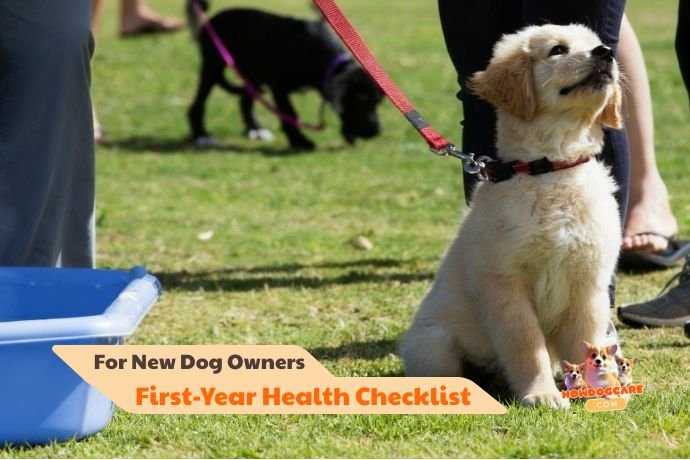So, you’ve just welcomed a four-legged fluffball into your life—congratulations! But now what? If you’re a first-time dog parent, you’re probably swimming in questions about health, food, vaccinations, and everything in between. That’s where the First-Year Health Checklist comes in. Think of this as your go-to blueprint to make sure your puppy thrives during those crucial early months. From choosing the right vet to mastering vaccinations and understanding growth needs, this guide will help you hit every health milestone without the stress.
Let’s take the guesswork out of puppy parenting.
The Importance of a First-Year Health Checklist
Why First-Year Care Matters for Puppies
Just like babies, puppies experience massive physical and emotional development in their first year. It’s when their immune systems build up, their habits form, and their bodies go through dramatic growth. Getting health care right in the first year means setting the stage for a long, happy, and well-behaved life.
Here’s why that first-year checklist is so crucial:
- Critical growth windows: Your pup’s bones, muscles, and organs grow rapidly during this period. Nutrition and medical attention are vital.
- Disease prevention: With a developing immune system, puppies are vulnerable to viruses, parasites, and infections.
- Behavioral foundation: Proper care helps avoid stress, which can cause behavior problems down the road.
By taking a structured approach to your dog’s first year, you can prevent long-term health issues, reduce anxiety (for both of you), and enjoy the journey of puppy parenting.
Preventative Health Measures to Start Early
Waiting until there’s a problem isn’t the best plan—especially when puppies can’t tell us what’s wrong. Instead, proactive care is key. Here’s what to prioritize from day one:
- Vaccinations to guard against deadly viruses
- Flea/tick/parasite control
- Scheduled deworming
- Routine vet visits
- Proper nutrition tailored to breed and size
- Teething and dental hygiene
- Early grooming exposure
Starting early means fewer emergencies and a healthier, happier pup.
Long-Term Benefits of Early Veterinary Care
Ongoing veterinary care in the first year builds a solid medical history, helping vets understand your dog’s needs as they grow. It also builds trust—your dog will learn that vet visits aren’t scary.
Early vet visits help:
- Detect congenital issues (like hip dysplasia or heart murmurs)
- Establish baselines for weight, temperature, and behavior
- Encourage consistent grooming, teeth brushing, and handling
- Educate you as the owner on best care practices
Think of it this way: investing in your dog’s first year health is like putting money in a savings account. The rewards multiply over time.
Choosing the Right Vet for Your New Dog
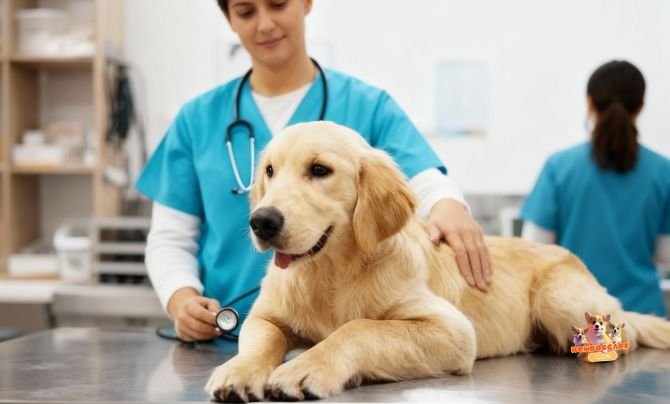
Questions to Ask a New Vet
Picking the right vet is just as important as choosing your own doctor. You want someone experienced, compassionate, and who understands your breed’s specific needs.
When interviewing vets, ask:
- Do you have experience with [breed name] puppies?
- What’s your vaccine protocol for first-year dogs?
- Do you offer emergency or after-hours services?
- What is the cost of a wellness plan or package?
- Do you support holistic or alternative care?
Also, pay attention to how the staff interacts with your pup. Friendly, calm, and gentle handling is non-negotiable.
Best Vet Clinics for Puppies in Your City or Region
If you’re located in Austin, Texas, here are three top-rated puppy vets:
- Firehouse Animal Health Center – Westlake
- Known for personalized wellness plans
- Central Texas Veterinary Specialty & Emergency Hospital
- Great for 24/7 care and emergencies
- ZippiVet – South Austin
- Offers wellness packages tailored to first-time dog parents
When choosing a vet, always read reviews and ask local dog parents for recommendations.
What to Expect During the First Vet Visit
That first vet visit can be nerve-racking—both for you and your puppy. But being prepared makes all the difference.
Here’s what typically happens:
- A full-body exam (checking eyes, ears, coat, joints, heart, and more)
- Weight and temperature check
- Discussion of vaccination schedule
- Stool sample test for worms
- Microchipping discussion
- Guidance on feeding, training, and behavior
Bring any records from the breeder or rescue, a fresh stool sample, and a list of your questions. Oh—and treats. Lots of treats.
Essential Vaccinations for Puppies and Dogs
Core vs Non-Core Vaccines Explained
Vaccinations are your puppy’s best defense against some truly nasty diseases. But not all vaccines are created equal. Here’s the breakdown:
- Core Vaccines (recommended for all dogs):
- DHPP (Distemper, Hepatitis, Parvovirus, Parainfluenza)
- Rabies
- Non-Core Vaccines (based on lifestyle or location):
- Bordetella (kennel cough)
- Leptospirosis
- Lyme disease
- Canine Influenza
Consult your vet to build a schedule based on where you live, how often your dog will socialize, and potential exposure to wildlife or travel.
First-Year Puppy Vaccination Schedule
Here’s a typical timeline for vaccinations in your pup’s first year:
| Age | Vaccine |
|---|---|
| 6–8 weeks | DHPP (1st dose) |
| 10–12 weeks | DHPP (2nd dose), Bordetella (optional) |
| 14–16 weeks | DHPP (final), Rabies (1st dose) |
| 6 months | Lepto, Lyme (if needed) |
| 12 months | DHPP booster, Rabies booster |
Always follow your vet’s advice on timing, especially if you adopted an older puppy or missed an early round.
What Side Effects to Watch For
Most vaccines are safe, but side effects can happen. Monitor your puppy for 24–48 hours after shots for:
- Mild lethargy or soreness
- Slight swelling at the injection site
- Temporary loss of appetite
Call your vet immediately if you notice:
- Persistent vomiting or diarrhea
- Swelling of the face or paws
- Breathing difficulties
- Seizures
Keep the number of your vet and nearest emergency clinic handy just in case.
Parasite Prevention for Puppies
Flea and Tick Control Options
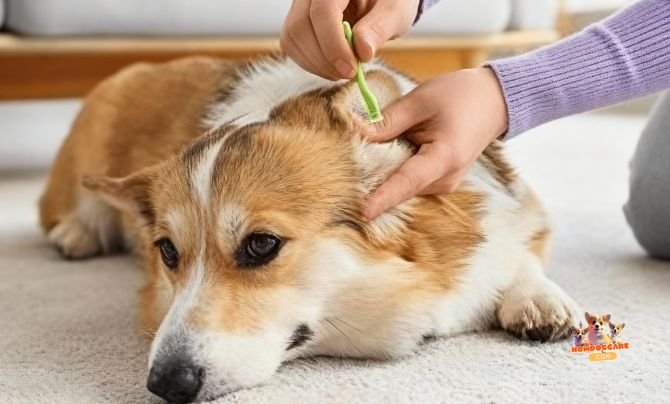
Fleas and ticks are more than just gross—they’re dangerous. They can transmit serious diseases like Lyme disease, ehrlichiosis, and tapeworms. For a new puppy, especially one exploring grassy parks or hiking trails, flea and tick prevention is non-negotiable.
There are several types of parasite control to consider:
- Topical Treatments (e.g., Frontline Plus, Advantage II): Easy to apply monthly, water-resistant, and effective against both fleas and ticks.
- Oral Medications (e.g., NexGard, Simparica): Chewable tablets that work systemically to kill parasites within hours.
- Flea Collars (e.g., Seresto): Offer 6–8 months of protection, great for busy owners.
- Natural Remedies: While some swear by them, they usually lack the strength to protect in high-risk areas.
Always consult your vet before starting any flea/tick control, especially for puppies under 8 weeks old. Some ingredients can be toxic at young ages or when combined with other meds.
Deworming Essentials and Schedules
Worms are almost guaranteed in young puppies—especially if they were in a shelter, born outdoors, or had little early care. Common types include:
- Roundworms
- Hookworms
- Whipworms
- Tapeworms
Symptoms can range from diarrhea and bloating to weight loss and poor coat condition. Even if there are no signs, your puppy likely needs a deworming regimen as part of their first-year checklist.
Typical deworming schedule:
| Age | Treatment |
|---|---|
| 2–3 weeks | First deworming |
| 4–6 weeks | Second round |
| 8 weeks | Begin monthly preventative |
| 12 weeks onward | Continue monthly as advised by vet |
Products like Panacur, Drontal, and Interceptor are commonly used and safe when dosed correctly.
Best Products for Parasite Protection by Size
Different sized dogs need different products and doses. Here are top-rated options based on breed size:
- Small Breeds (under 25 lbs):
- Best product: NexGard Small Dog Chewables
- Why: Fast-acting, beef-flavored, well-tolerated.
- Medium Breeds (25–60 lbs):
- Best product: Simparica Trio
- Why: All-in-one heartworm, flea, and tick control.
- Large Breeds (60+ lbs):
- Best product: Bravecto for Dogs
- Why: One chew lasts 12 weeks, ideal for big dogs.
Preventing parasites is much cheaper and easier than treating an infestation. Put it on your calendar monthly.
Nutrition and Growth Tracking in the First Year
Best Dog Food for Growing Puppies

The food you give your dog in their first year shapes their bones, brain, and overall health for life. Adult dog food simply won’t cut it—puppies need more fat, protein, and calories to fuel their rapid development.
Top-rated puppy foods by need:
- Best for Small Breeds:
- Royal Canin Small Puppy Dry Dog Food
- Small kibble, highly digestible, packed with calories.
- Best for Large Breeds:
- Hill’s Science Diet Large Breed Puppy
- Supports joint development, balanced minerals.
- Best Grain-Free Option:
- Blue Buffalo Freedom Puppy
- No corn, wheat, or soy. Great for sensitive stomachs.
Avoid switching foods too often, and always transition slowly to prevent GI upset.
How to Adjust Food Portions as Your Dog Grows
Puppies eat A LOT—but that amount changes quickly. Overfeeding can lead to obesity, while underfeeding may stunt growth.
Most puppy food bags have feeding guides based on weight and age, but here are general rules:
- 8–12 weeks: Feed 4 times/day
- 3–6 months: 3 times/day
- 6–12 months: 2 times/day
Use a measuring cup and monitor weight monthly. Adjust portions based on activity level and growth rate. Always provide fresh water and avoid free-feeding unless recommended by your vet.
Puppy Weight and Growth Milestones
Tracking your puppy’s weight is an easy way to make sure they’re developing properly. Here are average growth rates:
If your pup is significantly underweight or gaining too quickly, talk to your vet. Growth plates are still forming, and extreme weight changes can damage developing joints.
Spaying, Neutering, and Reproductive Health
Best Age to Spay or Neuter Your Puppy
The question of when to spay or neuter can spark debate—but most vets agree that doing it during the first year has health and behavioral benefits. Timing depends on your dog’s size and sex.
- Small breeds: 5–6 months
- Medium breeds: 6–8 months
- Large breeds: 9–12 months (to allow full skeletal development)
Benefits of early spay/neuter:
- Prevents unwanted litters
- Reduces risk of reproductive cancers
- Helps curb marking, humping, and aggression
However, studies now suggest waiting for larger breeds may prevent joint problems. Always discuss timing with your vet based on your dog’s breed and health.
Recovery Tips After Surgery
Post-op care is critical to avoid complications:
- Use a cone or surgical suit to prevent licking
- Keep your dog calm for 10–14 days
- Limit jumping and playing
- Monitor the incision for redness or discharge
- No baths until cleared by your vet
Give pain meds as prescribed and stick to soft bedding. If your pup seems especially lethargic or refuses food for more than 24 hours, call the vet.
Alternative Options and Vet Opinions
Some owners explore alternatives like:
- Vasectomy or Ovary-sparing spay: Allows hormone retention while preventing reproduction.
- Delayed spaying: Especially in working or large breed dogs.
The key is to balance reproductive health with long-term well-being. Get input from a trusted vet—there’s no one-size-fits-all solution.
Dental Care in Your Dog’s First Year
When to Start Brushing Your Dog’s Teeth
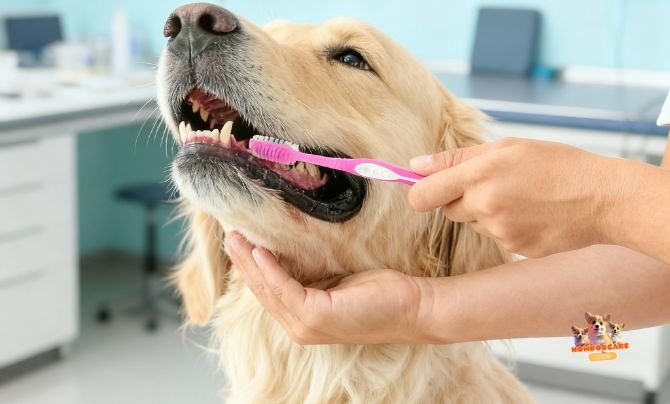
Yes—you should brush your dog’s teeth. And the earlier you start, the easier it’ll be. Dental care affects everything from breath to heart health, and neglecting it can lead to painful (and expensive) problems later.
Start around 8–10 weeks old, using:
- Puppy-safe toothbrush
- Dog-specific toothpaste (never human)
At first, just get them used to the brush and paste. Gradually increase brushing time to 2–3 minutes daily.
Top-rated Dental Treats and Toothbrushes
- Best Toothpaste: Vet’s Best Enzymatic Dog Toothpaste – Natural ingredients, great taste
- Best Brush Kit: Petrodex Dental Kit for Puppies – Includes brush, finger glove, and toothpaste
- Best Dental Chews: Greenies Puppy Dental Treats – Vet-recommended and gentle on tiny teeth
Pro Tip: Combine brushing with play or rewards for a positive association.
Signs of Early Dental Problems
Watch for:
- Bad breath (beyond “puppy breath”)
- Red or bleeding gums
- Yellow plaque buildup
- Difficulty eating
- Drooling or pawing at the mouth
Dental disease affects over 80% of dogs by age three. Stay ahead of the curve with early, consistent care.
Grooming Essentials for Puppies
First Bath: When and How

Your puppy’s first bath is a milestone—but it’s important not to rush it. Puppies under 8 weeks old usually don’t need a full bath unless they’re visibly dirty. Instead, use a damp cloth to wipe them down. Once they’re 8–10 weeks and have had some vaccines, you can go for a gentle bath.
Steps for a stress-free first bath:
- Use lukewarm water—not too hot or cold.
- Choose a puppy-specific shampoo to avoid skin irritation.
- Use a non-slip mat to prevent slipping.
- Keep the session short and calm—around 5 minutes.
- Dry gently with a towel or pet-safe blow dryer on low.
Never force your pup into water or spray their face directly. Make the bath fun and positive with treats and praise.
Best Puppy Shampoos and Brushes
- Best Puppy Shampoo: Earthbath Ultra-Mild Puppy Shampoo – Tearless, pH-balanced, and all-natural.
- Top Brush for Shedding Breeds: FURminator deShedding Tool – Reduces loose fur without irritating the skin.
- Top Brush for Long Hair Breeds: Hertzko Self-Cleaning Slicker Brush – Great for tangles and mats.
Regular brushing helps reduce shedding, prevent skin issues, and create a bonding moment with your pup.
Nail Trimming Tips and Tools for New Owners
Nail trimming often causes anxiety for new dog parents—and puppies too. Start early, and do it often to build tolerance.
Signs nails are too long:
- Clicking sounds on hard floors
- Splayed toes or limping
- Accidental scratching
Best Tools:
- Safari Professional Nail Trimmer – Easy grip and safety guard.
- Dremel Pet Nail Grinder – Smooth, quiet, and less risk of cutting the quick.
Trim once every 2–3 weeks, depending on growth. Always reward with treats after each paw.
Creating a Dog-Friendly Home Environment
Puppy-Proofing Tips for Health and Safety
Think of your puppy like a toddler—they’ll chew, sniff, and explore everything. Create a safe zone with:
- Baby gates or exercise pens
- Hidden cords or outlet covers
- Locked cabinets for cleaning supplies
- Off-limits areas for fragile items
- No access to human foods (like chocolate or grapes)
Keep small toys, batteries, coins, and anything chewable out of reach. Consider using a playpen or puppy-proofed room when you’re not actively supervising.
Best Crates and Beds for Small to Large Breeds
Your dog’s crate and bed are essential for comfort and safety. Choose based on size, breed, and temperament.
- Top-rated Crate for Small Dogs: MidWest Homes iCrate – Foldable, with divider panel.
- Best Bed for Large Dogs: Big Barker Orthopedic Bed – Durable, joint-friendly, and washable.
- For Chewers: K9 Ballistics Tough Bed – Virtually indestructible, chew-proof design.
Soft bedding and a safe space encourage relaxation and support proper development.
Keeping Your Home Clean and Germ-Free
With all the fur, drool, and occasional accidents, maintaining a clean space is a must.
Recommended cleaning essentials:
- Pet-safe Disinfectant Sprays: Nature’s Miracle Advanced Formula
- Enzymatic Cleaners: Remove urine smell and prevent repeat accidents.
- Litter-free Zone Mats: Great for entryways after walks.
Vacuum frequently and wash bedding weekly to keep allergens and bacteria at bay.
Related Articles
- Top 10 Best Dog Bath Tub Large Reviews (Updated Guide 2026)
- Top 10 Best Heated Orthopedic Dog Bed Reviews (Updated Guide)
- Best Vacuum for Dog Hair: Ultimate Guide for Pet Owners
- Top 10 Best Dog Muzzles Reviews (Updated Guide & Expert Tips)
- Top 10 Best Mushroom Supplements for Dogs with Cancer Reviews
Exercise and Mental Health for Growing Dogs
How Much Exercise Does a Puppy Need?
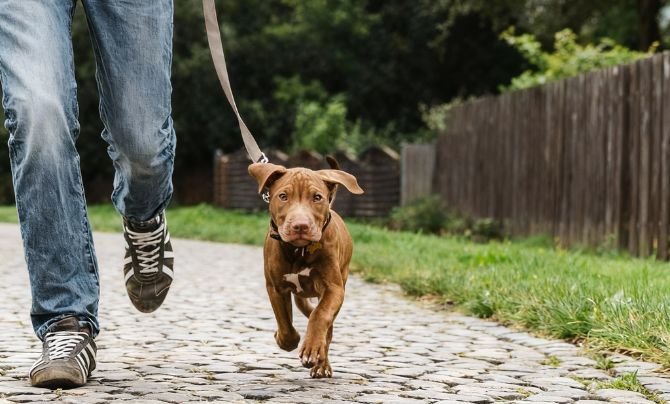
Puppies need a balance of play and rest. Over-exercising can harm growing joints, while under-exercising leads to destructive behavior.
Rule of thumb:
5 minutes of exercise per month of age, twice a day.
(For example, a 4-month-old pup needs 20 minutes x 2 = 40 minutes/day.)
Recommended activities:
- Leash walks
- Tug-of-war
- Fetch in the yard
- Puzzle toys or food mats
Always consider breed—working breeds need more stimulation than toy breeds.
Best Toys and Puzzle Games for Brain Development
Mental exercise is just as important as physical play. Use interactive toys to tire your puppy’s brain:
- Top Puzzle Toy: Outward Hound Hide-A-Squirrel – Great for nose work.
- Treat Dispenser: KONG Classic – Fill with frozen peanut butter or kibble.
- Snuffle Mats: Mimics foraging and slows eating.
Rotate toys weekly to keep interest high and boredom low.
Recognizing and Managing Puppy Anxiety
Dogs feel stress, too—especially when adapting to a new home. Common signs of anxiety include:
- Whining or barking when alone
- Destructive chewing
- Restlessness
- Loss of appetite
Tips to reduce stress:
- Consistent routines
- Crate training with calming aids
- Gradual alone-time training
- Calming treats or pheromone diffusers
Socializing early can prevent many behavioral issues later in life.
Pet Insurance and Budgeting for Vet Bills
Best Pet Insurance for First-Year Coverage
Vet care can add up fast—especially if your pup swallows something weird or breaks a bone. Pet insurance helps manage the unexpected.
Top Providers:
- Healthy Paws: High reimbursements, unlimited annual benefits.
- Fetch by The Dodo: Covers holistic care and dental.
- Lemonade Pet Insurance: Budget-friendly, app-based.
Look for plans that cover:
- Accidents and illnesses
- Diagnostic tests and surgeries
- Medications
- Preventative care (optional add-ons)
Sign up before any conditions are diagnosed to avoid exclusions.
Average First-Year Costs for New Dog Owners
Owning a dog is a rewarding investment—but it does come with costs.
Estimated first-year expenses:
| Category | Cost Range |
|---|---|
| Vet visits & vaccines | $300–$700 |
| Spay/neuter | $150–$400 |
| Food & treats | $250–$600 |
| Crate & bedding | $100–$300 |
| Toys & grooming | $100–$200 |
| Insurance | $300–$500 |
Total: ~$1,200 to $2,700
These numbers vary based on breed size, location, and lifestyle.
Budget-Friendly Tips for Health Essentials
- Join loyalty programs at pet stores for discounts
- Buy in bulk (especially food and poop bags)
- Use generic medications when possible
- Look for community vet clinics or low-cost vaccine events
A little planning goes a long way in keeping your dog healthy and your wallet happy.
Record Keeping and Tracking Your Puppy’s Health
How to Organize Vet Records and Vaccine Logs
Your dog’s medical history is just as important as yours. Keep a folder (physical or digital) with:
- Vaccine dates and upcoming boosters
- Spay/neuter certificate
- Microchip ID info
- Prescription history
- Emergency contact list
Use a binder, pet journal, or even a dedicated app.
Best Health Tracking Apps for Dog Owners
Go digital with one of these top-rated apps:
- PupTox – Logs food, vaccines, meds, and even walk times.
- PetDesk – Syncs with your vet, appointment tracking.
- Pawprint – Stores full health records and sends reminders.
Set reminders for monthly parasite preventatives, deworming, and annual boosters.
Building a Long-Term Health Timeline
Tracking your pup’s development helps identify changes early and spot trends. Document:
- Growth milestones
- Behavior changes
- Allergies
- Recurring health issues
The better your records, the easier it is for vets to diagnose and treat problems down the road.
Training and Socialization as Part of Overall Health
Why Training Impacts Mental and Physical Wellbeing

Training isn’t just about teaching tricks—it supports mental health, builds confidence, and prevents stress-induced behavior issues. Plus, a trained dog is more likely to live a safe, well-balanced life.
Start with basic commands:
- Sit
- Stay
- Come
- Leave it
Short sessions daily are more effective than long weekend marathons.
Puppy Classes vs Home Training
- Group Classes: Great for socialization, distractions, and guided lessons.
- At-home Training: Flexible, cost-effective, and good for shy pups.
Tip: Combine both. Train daily at home and enroll in group classes to reinforce skills with real-world stimuli.
Socialization Checklists for First-Year Success
Your goal is 100+ positive exposures by 16 weeks:
- Different people (kids, olders, men in hats, etc.)
- Dogs of all sizes
- Vacuum cleaner, car rides, thunder, etc.
- Surfaces (grass, tile, metal grates)
- Other animals (cats, squirrels, birds)
Proper socialization = fewer behavioral issues later in life.
Traveling With Your Puppy and Health Prep
Vet Certificates and Health Travel Requirements
Before flying or crossing state lines, check travel requirements:
- Up-to-date vaccination records
- Interstate health certificate (within 10 days of travel)
- Microchip documentation
- Airline-specific crate requirements
Contact your vet in advance—they’ll guide you through the paperwork.
Best Travel Crates and Carriers for Dogs

Top-rated products for safe travel:
- SherpaOriginal Deluxe Carrier – Airline-approved, great for small breeds.
- K&H Pet Products Travel Carrier – Collapsible and comfy.
- Petmate Sky Kennel – Sturdy, IATA compliant for international travel.
Bring a travel water bottle, collapsible bowl, and calming items (blanket, toy) for comfort.
How to Keep Your Puppy Healthy On-the-Go
- Don’t skip meals or medications
- Avoid shared water bowls in public spaces
- Keep them leashed and supervised
- Stop for potty and stretch breaks every 2 hours
- Watch for overheating or stress signs
Safe travel begins with thoughtful planning.
Common First-Year Health Issues and What to Watch
Diarrhea, Vomiting, and Warning Signs
New environments, diet changes, and stress can upset your puppy’s tummy. Occasional mild diarrhea is normal—but prolonged symptoms mean trouble.
When to call the vet:
- Bloody or black stool
- Vomiting + lethargy
- Dehydration (dry gums, sunken eyes)
- More than 2 days of diarrhea
Always monitor stool, energy, and appetite closely.
Skin Conditions and Allergies
Puppies are prone to itchy skin and allergies. Common triggers include:
- Fleas
- Food ingredients
- Pollen or grass
Watch for:
- Excessive scratching
- Red patches or bald spots
- Frequent ear infections
Try limited-ingredient diets or allergy testing if symptoms persist.
Knowing When to Call the Vet Immediately
Here are your emergency red flags:
- Collapse or unresponsiveness
- Seizures
- Blue gums or tongue
- Sudden swelling of face or throat
- Heatstroke symptoms
Trust your gut—when in doubt, always call your vet.
Conclusion: Start Smart, Stay Healthy
Raising a puppy is a once-in-a-lifetime adventure—and it starts with keeping them healthy, safe, and happy from day one. By following this First-Year Health Checklist, you’re giving your dog the best possible start in life. From vaccines and nutrition to grooming, parasite control, and emotional wellbeing, each step matters more than you might think.
With the right information and a solid plan, even first-time dog parents can feel confident every step of the way. Your puppy’s health is in your hands—start strong and enjoy every joyful, tail-wagging moment ahead.
FAQs
What should I do the day I bring my puppy home?
Schedule a vet visit, get them microchipped, start a feeding/potty routine, and begin crate training immediately.
Do I need pet insurance for my puppy?
Yes, especially during the first year. Unexpected illnesses or injuries can be costly. Insurance gives peace of mind and financial relief.
How do I know if my puppy is growing properly?
Track their weight weekly, monitor energy levels, and follow your vet’s growth chart. Consistent feeding and vet checks help spot any issues early.
Can I socialize my puppy before vaccinations are complete?
Yes, but carefully. Invite vaccinated dogs to your home and expose your puppy to safe environments like parks (avoid dog parks).
What’s the #1 mistake new dog owners make?
Waiting too long to start health routines—early training, vet visits, and socialization are key to a confident, well-adjusted adult dog.


